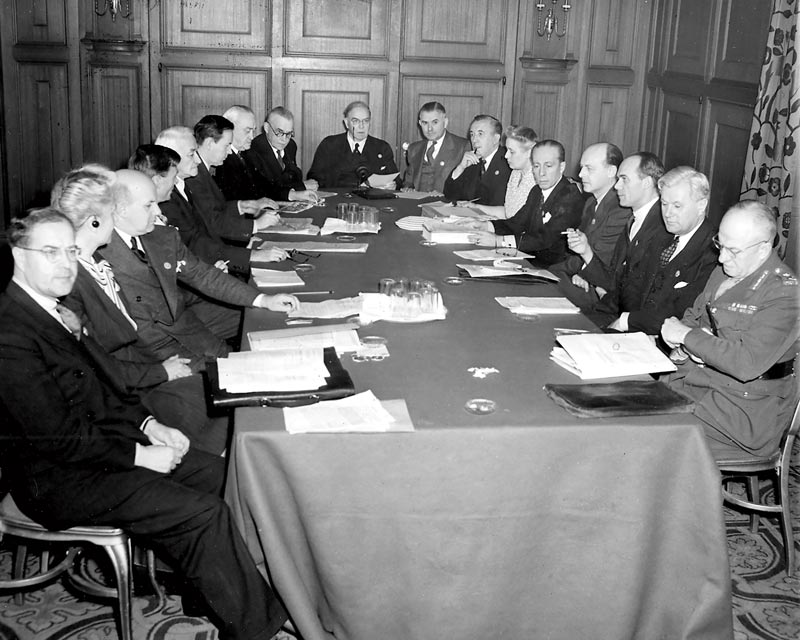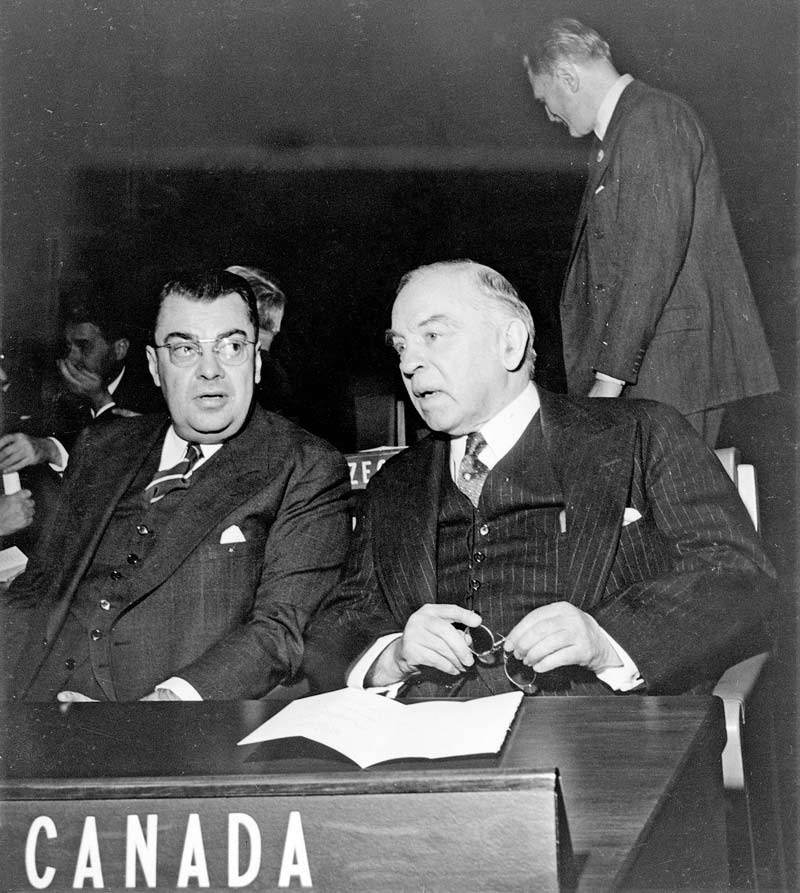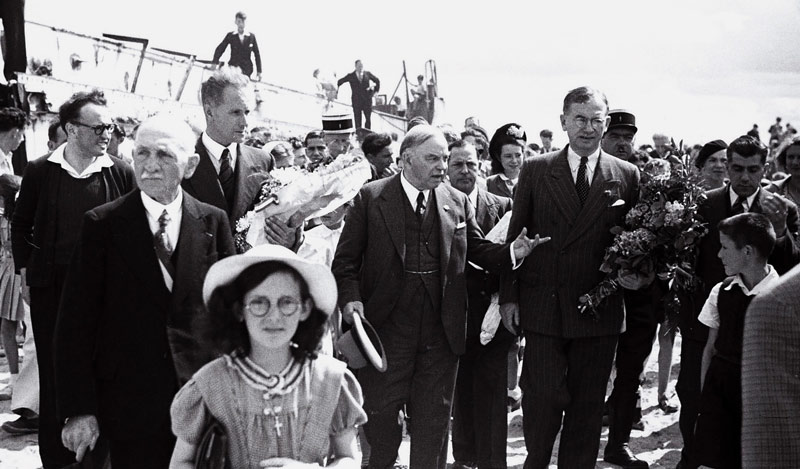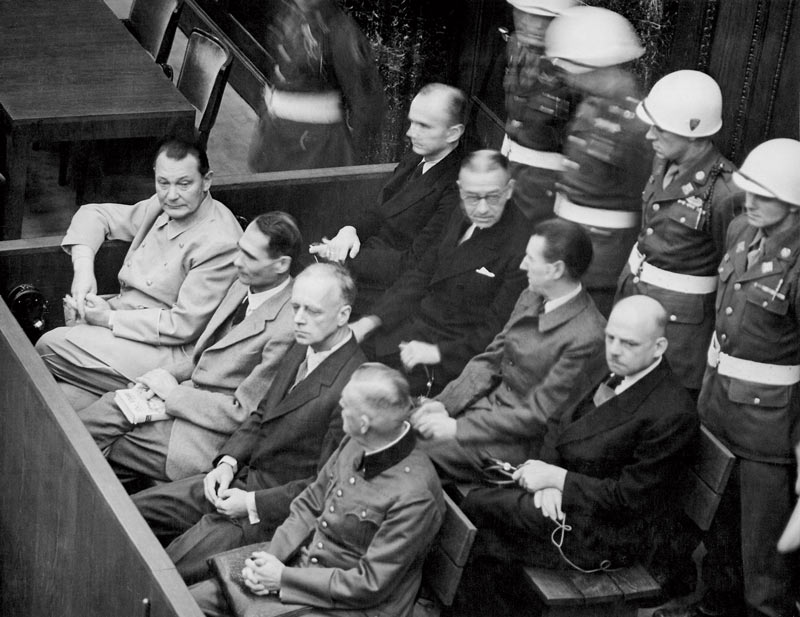In 1946, the Canadian prime minister attended a peace conference, visited battlefields and witnessed the Nuremberg trials

Prime Minister Mackenzie King visits Normandy while in France for an August 1946 meeting of world leaders that would determine the future of international politics for years to come. [Ken Bell/DND/LAC/3191757]
Canada had played a significant and substantial role in the victory of the democracies over Nazism and fascism, and 1945 was a year of triumphs for Prime Minister Mackenzie King and his nation.
Canada also was fully represented at the United Nations Conference on International Organization in San Francisco in the spring of 1945, and Ottawa’s fight to prevent the Security Council from deploying Canadian troops without Ottawa’s permission led to Article 44 in the UN Charter forbidding such action.
King himself was present for most of the meetings, something that greatly benefited him and his Liberal party in the June general elections, which the government party narrowly won.
In September, the defection of Igor Gouzenko, a Russian cipher officer, with documents confirming that the Soviet Union had been operating spy networks out of its embassy in Ottawa involved Canada in matters of the greatest importance with its Allies in Washington and London.

The Canadian delegation to the United Nations Conference meet in their hotel headquarters in San Francisco on May 10, 1945, to hear King declare Canada’s determination to bring the war with Japan to a successful conclusion. [UN Archive]
In May 1946, King attended the Commonwealth Prime Ministers’ Conference in London. Scheduling prevented all the leaders from being at the table at the same time, and the conference was really a series of bilateral discussions.
The new Labour government led by Clement Attlee faced terrible fiscal pressures, and it was as interested in seeing the Dominions pick up some of Britain’s defence burdens as the Conservatives had ever been.
For his part, Mackenzie King was uninterested in making commitments that inevitably would press Canada into a foreign policy directed by London, and the fact that the communiqué was anodyne was a victory. There had been only an “informal exchange” of views and a preference for flexible methods of communication over “any rigid centralized machinery.”
A few days later, King told Lord Addison, Attlee’s secretary of state for dominion affairs, that he might as well be blunt: Canada was “not in favour of a Commonwealth policy” on defence or foreign affairs. If Canada had an observer at a meeting, it had to be understood “it was simply for the sake of information and that no commitments were to arise nor were we to be regarded thereby as being consulted as distinguished from being informed….”
The prime minister soon returned to Canada.
He was back in Europe a few months later. While there were no German peace negotiations in the immediate future, Canada was a full participant in the Paris Peace Conference in the summer of 1946.
The conference was another step toward the looming Cold War.
This was a second-tier meeting, its purpose to negotiate peace treaties between the victors and the Nazis’ satellite nations—Hungary, Bulgaria, Italy, Romania and Finland.
“Canada’s interest in the successful outcome of the deliberations of this conference is obviously less immediate and direct than that of some of the participating countries,” King stated in an address to the conference. “Our concern is to see that…the peace treaties will be based upon broad and enduring principles of justice and equity.”
With no pressing interests in the negotiations, the simple fact that Canada was present was recognition of its status. For the Great Powers, however, the conference was another step toward the looming Cold War, and the Western allies faced off with the Soviet Union on procedural issue after procedural issue.

King and health and welfare minister Paul Martin Sr. attend the UN General Assembly in Flushing Meadows, N.Y., in October 1946. [Leo Rosenthal/LAC/3201412]
The lack of progress freed King and his party to leave the peace conference on Aug. 10 to visit Dieppe and the Normandy battlefields, where the Canadians had fought and so many had died.
King was greeted with fervour by dignitaries and ordinary French citizens, children singing “O Canada,” arches with banners proclaiming “Honneur aux Canadiens,” and speeches from mayors and ministers.
But the battlefields were the chief reason for the visit. Colonel Charles Stacey, the Canadian Army historian, accompanied the prime minister to provide explanation and context. He did not always please King, not least when he pointed out the shattered tanks used at Estrées-la-Campagne, where the British Columbia Regiment’s Shermans had been outgunned and destroyed by German Panther and Tiger tanks.
“One felt it was almost a sort of worship of these various instruments of destruction. Horrible looking things. All rusted. Piled up.”
For his part, Stacey, never an admirer of King, was not impressed. “Here in the heart of the Norman countryside there was no crowd to cheer; nothing for a politician.” Clearly the historian found the politician boring, an old gentleman with no particular interests, no special conversational skills.
“One should remember too,” Stacey wrote, “that he is probably past his best; he is 72….”
The Canadian cemetery at Bretteville-sur-Laize still had wooden crosses marking the graves.
“It touched me deeply to see between the graves that were named, here and there, one simply classified as an ‘unknown soldier,’” wrote King. “I found it quite impossible to give any expression to my feelings. Indeed, as I said, I felt silence was the only language in such a place.”
Moved by the sea of graves of his countrymen, King’s lack of comment was exactly the right acknowledgment of sacrifice.
On his visit to Juno Beach, where the 3rd Canadian Division had landed on D-Day, there were cheering crowds, flags and speeches galore, but the prime minister revealed how little he knew of the cross-Channel invasion and the creation of the two Mulberry harbours.
“I did not realize until yesterday that our troops had to land on shores, to clear the beaches and make it possible to have ships sunk which constituted a harbour for the landing craft and the landing of large numbers, etc.”

King tours the beach at Courseulles-sur-Mer. He later climbed aboard the remains of a landing craft used by soldiers of the Régiment de la Chaudière on D-Day. [Juno Beach Centre]
King’s next and last visit to the battlefields was to Dieppe on Aug. 18, one day before the fourth anniversary of the disastrous raid of 1942.
“It was sending men to certain death without a ghost of a chance.”
King looked at the beach at Puys, where the Royal Regiment of Canada had landed, and noted in his diary that it “seemed to be [one] of the most difficult for a landing…. One sees cliffs rising steeply out of the sea; then there was a narrow sort of valley which led into the town, and then on the other side a very high hill on top of which was a gun emplacement” that commanded “a complete view of the beach and one man with the help of the gun…could destroy men as rapidly as they could land.”
King had a good eye for the ground and for tactics, and his conclusion was correct.
“I really felt as though the men who had planned that raid ought to have been cashiered…. It was sending men to certain death without a ghost of a chance…. It just made me indignant beyond words.”
The next day, the anniversary of the raid, King attended ceremonies in the Dieppe council chamber and at the main beach in front of the town.
He tried to find some reason for the assault, that “in the sum total of things, it had been of some real contribution.” But he did not believe this. “I confess in my heart I felt that it had been a terrible thing to send men into that area to discharge a mission that could only end in death….”
Still the public reception cheered him. Everywhere there were large crowds of French citizens, young and old, cheering the prime minister and the Canadian soldiers who paraded through the town.
“We must have walked for a mile,” King wrote. “There were crowds cheering on both sides of the street all the way. From windows they began throwing flowers. Little children clapping their hands; dogs barking; old soldiers wearing medals. All happy and rejoicing, singing ‘Vive le Canada.’ In reply, we said ‘Vive la France.’”
After the Dieppe ceremonies, King spent another day at the peace conference in Paris. He and his entourage then flew to Berlin to tour the ruins of Hitler’s capital.
It was an “appalling sight,” King said. “Tiergarten, one waste of ground. Beautiful buildings demolished beyond recognition. The whole centre of the city all but totally destroyed.”
The Canadian party then visited the Chancellery and Hitler’s bunker, his “place of final refuge.” King picked up a piece of a wall, “an interesting souvenir” for a man who for years had collected ruins for his Kingsmere estate. He was then given a tile from the Führer’s bathroom.
King was appalled when he saw the bunker and the place where the bodies of Hitler and Eva Braun, his mistress and last-minute wife, were burned. They were “vermin and rats and the like, with holes in the ground.”
King and his entourage then boarded a flight for Nuremburg, where the trials of 20 senior Nazi leaders were close to conclusion before an international tribunal. King had met some of Hitler’s henchmen on his visit to Berlin in 1937; now he saw Hermann Göring, Joachim von Ribbentrop, Konstantin von Neurath and the others in very different circumstances.
Göring, King wrote, “had shrunk to almost half the size as I remember him. Von Ribbentrop, the foreign minister [and before the Great War a wine salesman in Ottawa] looked a mere shadow of himself. An old weary looking man, taking voluminous notes.”
Von Neurath was foreign minister in 1937. He “has got much older. He sat with his hands folded across his lap; hardly turning his head, looking straight ahead. A very pathetic solitary figure. When one thinks of how pleasant he was as a gentleman in a high position…it seemed an appalling fate—an example of a man who got in with the wrong gang—got to where finally he could not get out of [the] situation he found himself in.”
Eight years earlier, von Neurath had given his Canadian visitor a long justification for German anti-Semitism. After the Holocaust, a broken man, he was in the dock with the other “real criminals.”
King then visited the prison cells in which the Nazi leaders were housed. They could exercise daily, but the rest of their time was in solitary confinement: “How right it is to what they have given to others to endure.”
Back in Paris for his last day at the peace conference, King attended a meeting of Commonwealth delegates presided over by Ernest Bevin, the British foreign minister.
In a discussion on whether or not a particular issue should go to the United Nations for consideration, King was outspoken.
“I expressed myself as believing the U.N.O. was just coming into being and it was the last thing that should be done to let forty or fifty nations [discuss] these questions. I really feel the U.N. threatens to become as great a menace as the League of Nations—a lot of immature, untrained minds wishing to register their positions, etc.”
For King, and for some Canadian diplomats as well, the bloom was off the rose.
The conference and King’s visit to Europe were over. He returned to Canada with less than two years left in his long tenure as Canadian leader.
Fusty and fussy, King was not impressive up close. Stacey’s grumpy comments in Normandy were not wrong. But King had a clear sense of what his people wanted and needed, and in the more than two decades he led the government, he had changed Canada dramatically. A relatively poor, largely agricultural nation at the end of the Great War, by 1946, Canada had become an industrial power that, for example, built the vehicles on which much of the Commonwealth armies had rolled to victory.
No one much admired King as a man, but seen with the proper perspective, he was a leader.
Advertisement






















